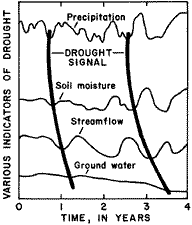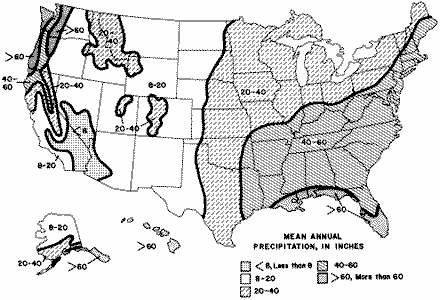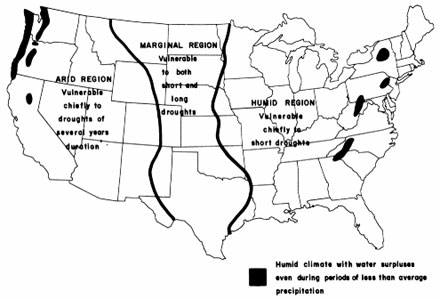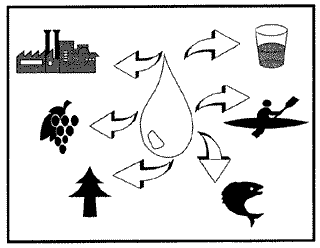[an error occurred while processing this directive]
Drought
U.S. Geological Survey Open File Report 93-642
This report is also available in pdf,
it is 1MB.
What is a drought?
A drought is a period of drier-than-normal conditions
that results in water-related problems. Precipitation
(rain or snow) falls in uneven patterns across the country. The amount of precipitation
at a particular location varies from year to year but, over a period of years,
the average amount is fairly constant. In the deserts of the Southwest, the
average precipitation is less than 3 inches per year. In contrast, the average
yearly precipitation in some parts of the Northwest is more than 150 inches.
The amount of rain and snow also varies with the seasons. In some areas, most
of the yearly precipitation falls in early spring. In the Southeast, most of
the yearly precipitation falls during the hurricane seasons in late summer and
fall. Even if the total amount of rainfall for a year is about average, rainfall
shortages can occur during a period when moisture is crucially needed for plant
growth.
When no rain or only a very small amount of rain falls, soils can dry out and
plants can die. When rainfall is less than normal for several weeks, months,
or years, the flow of streams and rivers declines, water levels in lakes and
reservoirs fall, and the depth to water in wells increases. If dry weather persists
and water-supply problems develop, the dry period can become a drought.
When does a drought begin?
 The
beginning of a drought is difficult to determine. Several weeks, months, or
even years may pass before people know that a drought is occurring. The end
of a drought can occur as gradually as it began. Dry periods can last for 10
years or more. During the 1930’s, most of the United States was much drier
than normal. In California, the drought extended from 1928 to 1937. In Missouri,
the drought lasted from 1930 to 1941. That extended dry period produced the
“Dust Bowl” of the 1930’s when dust storms destroyed crops and
farms.
The
beginning of a drought is difficult to determine. Several weeks, months, or
even years may pass before people know that a drought is occurring. The end
of a drought can occur as gradually as it began. Dry periods can last for 10
years or more. During the 1930’s, most of the United States was much drier
than normal. In California, the drought extended from 1928 to 1937. In Missouri,
the drought lasted from 1930 to 1941. That extended dry period produced the
“Dust Bowl” of the 1930’s when dust storms destroyed crops and
farms.
The first evidence of drought usually is seen in records of rainfall. Within
a short period of time, the amount of moisture in soils can begin to decrease.
The effects of a drought on flow in streams and rivers or on water levels in
lakes and reservoirs may not be noticed for several weeks or months. Water levels
in wells may not reflect a shortage of rainfall for a year or more after a drought
begins.
Does a shortage of rain mean a drought will occur?
A period of below-normal rainfall does not necessarily result in drought conditions.
Some rain returns to the air as water vapor when water evaporates
from water surfaces and from moist soil. Plant roots draw some of the moisture
from the soil and return it to the air through a process called transpiration.
The total amount of water returned to the air by these processes is called evapotranspiration.
Sunlight, humidity, temperature, and wind affect the rate of evapotranspiration.
When evapotranspiration rates are large, soils can lose moisture and dry conditions
can develop. During cool, cloudy weather, evapotranspiration rates may be small
enough to offset periods of below normal precipitation and a drought may be
less severe or may not develop at all.

Where do droughts usually occur?
Some areas of the United States are more likely to have droughts than other
areas. In humid, or wet regions, a drought of a few
weeks is quickly reflected in a decrease in soil moisture and in declining flow
in streams. People who use water from streams in these areas may face water
shortages as soon as streamflow begins to decline. In arid,
or dry regions, people rely on ground water and water in reservoirs to supply
their needs. They are protected from short-term droughts, but may have severe
problems during long dry periods because they may have no other water source
if wells or reservoirs go dry.

What can be done to solve water problems during periods of drought?
When droughts occur, there is not enough water to supply all needs. If water
is diverted from streams to irrigate crops, streamflow will decrease. Reservoirs
that may already be at low levels will be drawn even lower to supply water for
power generation, to supply water to downstream cities and towns, or to maintain
river levels high enough for navigation. Decreasing water levels in rivers,
lakes, and reservoirs may cause problems for fish and wildlife that depend on
wetlands or water bodies to survive.

Balancing the needs of all the users of a water supply during a drought can
be very difficult. Local, State, and Federal agencies must make decisions on
how water will be used to satisfy the most critical needs and to reduce economic
and environmental problems. In times of severe drought, water users must cooperate
and share the limited amount of water available to protect the critical needs
of people, fish and wildlife, agriculture, and industry.
Conserving water is very important during drought periods. Water saved by one
user may be enough to protect the critical needs of others. Irrigation practices
can be changed to use less water or crops that use less water can be planted.
Cities and towns can ration water, factories can change manufacturing methods,
and individuals can practice water-saving measures to reduce consumption. If
everyone reduces water use during a drought, more water will be available to
share.
For additional information, please contact:
- U.S. Geological Survey
Water Resources Division
12201 Sunrise Valley Dr.
Reston VA 20192
Chief, Office of Ground Water
Telephone: (703) 648-5035 FAX: (703) 648-5722
http://water.usgs.gov/ogw/
OR
Chief, Office of Surface Water
Telephone: (703) 648-5305 FAX: (703) 648-5722
http://water.usgs.gov/osw/
 The
beginning of a drought is difficult to determine. Several weeks, months, or
even years may pass before people know that a drought is occurring. The end
of a drought can occur as gradually as it began. Dry periods can last for 10
years or more. During the 1930’s, most of the United States was much drier
than normal. In California, the drought extended from 1928 to 1937. In Missouri,
the drought lasted from 1930 to 1941. That extended dry period produced the
“Dust Bowl” of the 1930’s when dust storms destroyed crops and
farms.
The
beginning of a drought is difficult to determine. Several weeks, months, or
even years may pass before people know that a drought is occurring. The end
of a drought can occur as gradually as it began. Dry periods can last for 10
years or more. During the 1930’s, most of the United States was much drier
than normal. In California, the drought extended from 1928 to 1937. In Missouri,
the drought lasted from 1930 to 1941. That extended dry period produced the
“Dust Bowl” of the 1930’s when dust storms destroyed crops and
farms.


